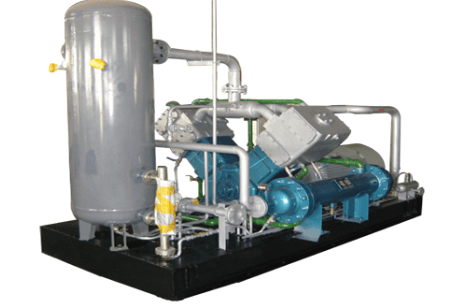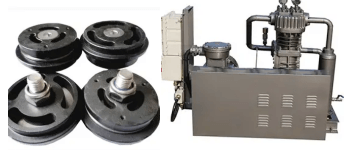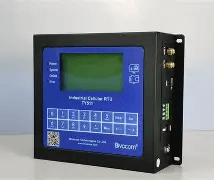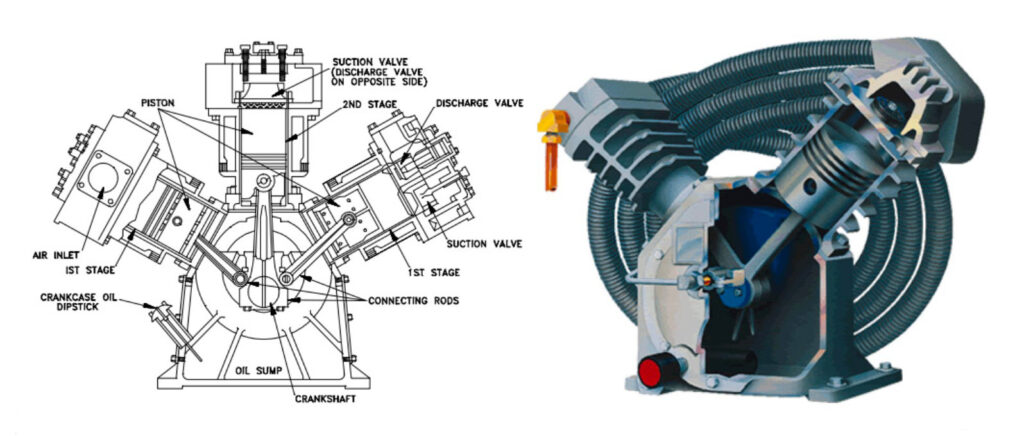In oil and gas field development, associated gas produced alongside crude oil has long been considered a “byproduct” or even “waste.” Due to the difficulty of collection, the complexity of its composition, and the drastic pressure fluctuations, many oil fields choose to directly burn and vent it, resulting not only in resource waste but also serious environmental problems and carbon emission pressures.
However, with increasing environmental protection requirements and growing awareness of energy value, LPG compressors are gradually becoming core equipment for the recovery and resource utilization of associated gas in oil and gas fields. LPG compressor solutions, represented by MINNUO, have successfully transformed the previously burned waste gas into high-value LPG products through their advanced technology and extensive field application experience, achieving a win-win situation for both economic and environmental benefits.

I. Industry Pain Points and Technical Requirements for Associated Gas Recovery
In the process of oil and gas field development, associated gas recovery has always faced numerous severe challenges. These gases, produced along with crude oil, are characterized by drastic fluctuations, complex composition, high impurity content, and remote geographical locations. During the development process, gas well production fluctuates significantly, with daily variations potentially exceeding 30%, placing extremely high demands on the stability of recovery equipment. Meanwhile, the gas often contains high concentrations of corrosive media such as H₂S and CO₂, with H₂S concentrations reaching tens of thousands of ppm. This not only triggers hydrogen-induced cracking and sulfide stress corrosion but also poses a serious threat to the safety of on-site operators.
Besides the complex composition, the feed gas also carries various contaminants such as condensate oil, formation water, drilling fluid residues, and fine sand particles. Once these impurities enter the equipment, they can easily cause cylinder scratches, valve jamming, and seal failure, severely affecting the reliable operation of the equipment. Even more challenging is that most well sites are located in remote areas such as deserts, Gobi, or offshore platforms. These locations often lack stable power grids and make it difficult to maintain long-term personnel presence, making remote operation and maintenance a critical problem.
Faced with these complex operating conditions, traditional compressors often fall short. They either frequently shut down due to their inability to adapt to pressure fluctuations, experience frequent malfunctions due to corrosion and contamination, or ultimately become idle in remote areas due to maintenance difficulties. These limitations force a large amount of associated gas to be directly vented and burned, resulting in both resource waste and environmental pollution. To address these pain points, MINNUO LPG compressors offer a systematic solution. Their equipment features a wide inlet pressure range and is equipped with an optional variable frequency drive system, capable of adjusting speed in real time to adapt to changes in gas volume. Regarding corrosion, the standard “acid gas service package” uses stainless steel for key components, effectively resisting H₂S and CO₂ corrosion. A multi-stage separation and filtration system removes over 90% of liquid and solid particles, protecting internal components. The skid-mounted design and remote telemetry system enable rapid deployment and unattended operation. This comprehensive technological integration allows LPG compressors to operate stably in the most demanding oilfield environments, truly transforming associated gas from a “burden” into a “wealth.”

II.Key Technological Highlights of the LPG Compressor
MINNUO LPG compressors incorporate multiple innovative technologies, showcasing superior performance advantages. Its variable frequency drive system monitors pressure changes through high-precision sensors, adjusting motor speed within seconds. Actual application data shows that this can increase gas recovery rate by over 25% while reducing energy consumption by approximately 30%. These innovative technologies not only solve long-standing pain points in the industry, but also elevate gas recovery to a new level of intelligence and systematization.

Variable frequency drive technology, as a core breakthrough, demonstrates outstanding adaptability. The system monitors changes in intake pressure in real time using high-precision sensors. When gas well production fluctuates, the inverter can adjust the motor speed within seconds, achieving dynamic matching between compression capacity and gas supply. This intelligent adjustment, “moving with the gas,” avoids equipment wear caused by frequent start-stop cycles of traditional fixed-speed compressors during low-production periods, while maximizing gas recovery during high-production periods. Field data shows that this technology can increase gas recovery rate by more than 25% while reducing energy consumption by approximately 30%, truly realizing the “every grain returned to the silo” recovery concept.

Faced with the corrosion challenges of high concentrations of H₂S and CO₂ in associated gas, the equipment employs a comprehensive corrosion-resistant solution. Key components such as cylinders, valves, and piston rods are made of SS316L stainless steel or duplex steel. These materials undergo special heat treatment processes, exhibiting excellent resistance to sulfide stress corrosion cracking. More notably, the integrated design of the “acid gas service package” is noteworthy. It includes specialized H₂S-resistant sealing materials, a cooling system optimized for acidic environments, and a special surface treatment process, forming a complete protection system. In practice at a high-sulfur gas field in Sichuan, this system has operated stably for over 8,000 hours without any corrosion-related failures.
To address the complex impurities in associated gas, the high-efficiency separation and filtration system constructs a multi-stage protection network. The first-stage gravity separator removes over 90% of liquid and solid particles, the intermediate centrifugal separator further refines the filtration, and the final coalescing filter captures micron-sized droplets. This system is also equipped with an intelligent drainage device that automatically discharges the separated liquid based on the liquid level, ensuring continuous and stable operation. Application in the Tarim Oilfield has proven that this system effectively handles harsh conditions with sand content as high as 50 mg/m³, significantly extending equipment maintenance cycles.
The combination of modular design and remote control completely transforms the deployment and maintenance model of traditional compressors. The entire unit adopts a skid-mounted design, integrating the compressor, power system, control unit, and auxiliary equipment onto a compact steel structure base, enabling rapid deployment with “ready-to-use” capability. Even more commendable is the advanced remote monitoring system, which transmits operational data in real time via satellite/4G networks, allowing engineers to monitor equipment status, adjust operating parameters, and diagnose faults from thousands of miles away. In a remote oilfield in Inner Mongolia, 12 such compressors operate completely unattended, requiring only periodic inspections, significantly reducing operating costs.

These technological innovations are not isolated entities, but rather a synergistic and organic whole. Variable frequency technology ensures the equipment always operates at its optimal condition, corrosion-resistant design guarantees the long-term reliability of core components, the separation system provides the equipment with clean “blood,” and modularity and remote control endow the equipment with the flexibility to adapt to various environments. It is this systematic technological integration that enables modern LPG compressors to operate continuously and stably in the most demanding oilfield environments, providing reliable technical support for associated gas recovery in oil and gas fields.
III.Diverse Application Scenarios and Significant Benefits
MINNUO LPG compressors have demonstrated outstanding application value in various oilfield environments.
In the early production stages of new oilfields, traditional practices often necessitated the direct venting and combustion of associated gas due to the lack of pipeline infrastructure. Now, with the adoption of LPG compressors, this situation has been fundamentally changed. Taking a newly developed oilfield in Xinjiang as an example, two skid-mounted compressors were deployed in the early stages of oil production to compress the recovered associated gas into CNG, which was then sold to surrounding industrial users via specialized transport vehicles. This initiative not only generated substantial cash flow within six months of the new oilfield’s commissioning, but more importantly, it achieved zero venting from day one, avoiding approximately 30,000 tons of carbon dioxide emissions annually. This “production, recovery, and profit generation simultaneously” model is becoming a new industry standard for new oilfield development.
For mature oilfields entering a stable production phase, the value of associated gas recovery lies more in improving quality and efficiency, and reducing emissions and costs. In a block of the Liaohe Oilfield, by installing LPG compressors at the gas gathering station, low-pressure associated gas that was previously unable to enter the pipeline network was successfully pressurized and reinjected for gas lift oil production. This innovative application not only replaced some externally purchased gas, saving over 6 million yuan annually, but also increased the associated gas recovery rate of the entire block by 40%. Furthermore, with the maturation of the national carbon trading market, this project can also obtain additional carbon sink revenue annually through certified emission reductions, truly achieving a double harvest of economic and environmental benefits.

In the development of marginal gas fields, LPG compressors play an irreplaceable role. In the Ordos Basin, some scattered small gas fields, due to their small reserves and remote locations, make long-distance pipeline construction clearly uneconomical. By adopting a flexible “compressor + CNG/LPG tanker” model, these previously undevelopable marginal resources have been revitalized. In practice, the compressor unit compresses the gas to a transportable state, directly fills it into dedicated tankers, and then transports it to gas stations or industrial users in surrounding cities. This “mobile” recovery solution not only significantly reduces upfront infrastructure investment but also substantially lowers the project’s break-even point, making even small gas fields with a daily output of less than 5,000 cubic meters economically viable.
IV.Industry Trends and Selection Recommendations
With the accelerated global energy transition, methane emission reduction and carbon tax mechanisms are reshaping the development landscape of the oil and gas industry. According to the latest industry data, associated gas recovery has become a key indicator for measuring the sustainable development level of oil and gas companies. Against this backdrop, selecting a suitable LPG compressor is particularly important. MINNUOlta LPG compressors hold ISO 9001 quality management system certification and ATEX Zone 2 explosion-proof certification. Their design and manufacturing comply with NORSOK/API standards, and factory acceptance testing includes surge and transient response tests to ensure equipment reliability under various operating conditions. Their global remote monitoring and diagnostic system, rapid-response field service team, and strategic spare parts inventory provide users with full lifecycle service support.
International customer feedback fully demonstrates the superior performance of MINNUOlta products. Canadian users praised their VFD system for “perfectly handling pressure fluctuations,” Omani users commended their desert kit for “excellent reliability during sandstorm seasons,” and Russian users confirmed “no corrosion issues for two years in high H₂S environments.” These real-world examples provide strong evidence of the reliability and adaptability of MINNUOlta compressors. It is worth noting that industry certifications have become an important reference for equipment selection. Equipment with ATEX explosion-proof certification and API standard certification not only signifies higher safety and reliability but also represents the comprehensive strength of the equipment manufacturer. In today’s safety- and environmentally conscious era, these certifications have effectively become “passports” to the mainstream market.
Conclusion
MINNUO LPG compressors have transcended the scope of traditional gas booster equipment, becoming a key driver for intelligent, green, and efficient operation of oil and gas fields. Leveraging over thirty years of technological accumulation and global project experience, MINNUO not only provides high-performance equipment but also offers complete associated gas recovery solutions. In the current context of energy transition, choosing MINNUO signifies choosing a more efficient, environmentally friendly, and sustainable path for oil and gas field development, directly impacting a company’s competitive position and development potential in the future energy landscape.
MINNUO LPG compressors, with their superior technical performance and reliable product quality, are helping global oil and gas field customers transform associated gas from a “burden” into tangible “wealth,” contributing positively to global carbon reduction goals while achieving economic benefits.





 Email
Email sales:+86 15366749631
sales:+86 15366749631

